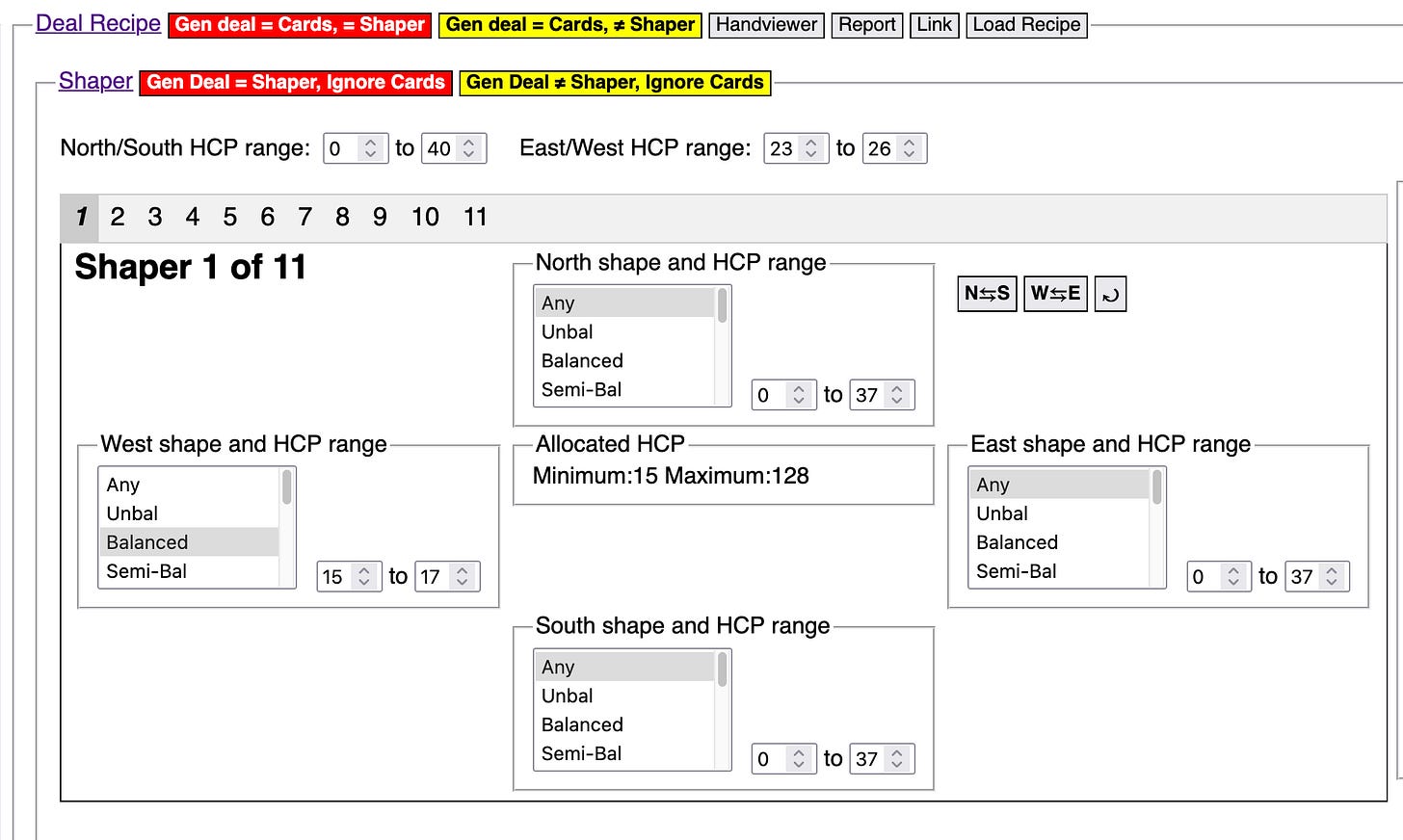Define Combined Point Ranges for Partners
An obvious thing that wasn't obvious to me, until now.
If you are reading this post in an email, the links to the deal generator may not work due to the way Substack modifies them for emails. To avoid that problem, click on or near the title of this post above in your email and read the post directly on the blog.
Hi, bridge pals.
The deal generator at this link has been updated with a new feature. I have been trying to only update the main live version of the generator once a month, but this feature is too compelling to hold back for the May release.
Today’s newness is the North/South HCP range and the East/West HCP range near the top of the Shaper panel, up above the shaper tabs.
The shaper panel tutorial describes these settings in a general way. Here, I’ll show you a few ways to use this feature.
How Can I Give North/South 22+ Points?
No other requirements—just the combined points total.
This was the seemingly simple request that caused me to add the now obvious feature.
In thinking about deal design, I had always thought in terms of a specific seat having opening points. So it was easy to always give a seat 12/13+ and their partner 10+. There you go: 22+ combined points. And this does work fine if you are starting off with a well-developed sense of the type of bid you are trying to promote.
But what if you want to teach or explore some basic partnership point totals without predetermining the bidding scenario? I won’t describe all the ways it is dissatisfying to do this with the North and South or the East and West point ranges in the shaper tabs—you can go try it yourself. You will easily allocate 22+ points, but you will have to be too specific about point distributions, and you can’t manually define all of them.
I go into this stuff about development agony because it is relevant to counting points when you are playing or teaching. 22+ points in a partnership sounds great, but it’s all about the split, and the relative quality of the hands.
So the first and easiest thing you can do now is simply allocate points to a partnership, like this:
Give a Partnership a 1NT opening hand, and total points that vary from just below to just above game—say a combined total of 23 to 26 HCP.
This is another one that you could kind of do, in a not very satisfying way, using the point ranges in two seats. Give West 15-17 points and a balanced hand, and give East 8-9 points. This will reliably deliver a combined 23-26 points.
But you know what it doesn’t deliver?
15 & 10; 15 & 11; 16 & 7; 17 & 6; 17 & 7.
That’s five perfectly valid and study-worthy point combinations that you won’t get using overly-specific point ranges in two seats.
Partnership point range solves that. Here it is, with no points allocated to East. West’s points, and the partnership point range, do all the work and, if you generate enough deals, you would eventually see every point combination that adds up to 23-26:
You can change that partnership point range to suit the topic of study. Want to practice or teach 1NT openers with slam potential? Fine. Start with that same 1NT opener definition, but change the partnership point range to 30-40, and get ready to practice your slam bidding.
Since I was oblivious to the need for this feature until a teacher asked how to do it (thinking, so kindly, that surely I had it buried somewhere on the page), I’m sure you all can think of many ways to use partnership point ranges in your own deal designs. Have at it!
Happy dealing!




